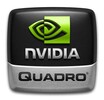NVIDIA Quadro M620 vs NVIDIA Quadro M1200 vs NVIDIA Quadro M520
NVIDIA Quadro M620
► remove from comparisonThe 28nm NVIDIA Quadro M620 is a mid-range DirectX 12 (FL 11_0) and OpenGL 4.5-compatible graphics card for mobile workstations. It is a 1st generation Maxwell-based GPU built on the GM107 architecture with 512 of the 640 shader cores activated. Therefore, the GPU is not similar to any current consumer card. The Geforce GTX 950M, for example, uses the full 640 shader cores. The older Quadro M1000M offers very similar specs (same amount of shader cores and also based on the same chip but more graphics memory), but was intended for the Skylake generation. The M620 is intended for the Kaby Lake generation.
The Quadro series offers certified drivers that are optimized for stability and performance in professional applications like CAD or DCC. OpenGL performance, for example, should be significantly better compared to GeForce graphics cards of similar specifications.
Performance
Due to the smaller amount of memory, the Quadro M620 should be slightly slower than the older Quadro M1000M. However, the exact clock speeds are not known up to now. In early benchmarks we have, the M1000M is about 9 % faster than the M620 in SPECviewperf 12.
Using CUDA (Compute Capability 5.0) or OpenCL 1.2, the cores of the Quadro M620 can be used for general calculations.
Power Consumption
The power consumption of the Quadro M620 is rated for a 30 Watt TGP including the board and memory components (21.2 Watt TDP), which is 10 Watt lower than the M1000M (which offers more memory). Therefore, the card is suited for 15-inch notebooks and greater.
NVIDIA Quadro M1200
► remove from comparison
The 28 nm Nvidia Quadro M1200 is a mid-range DirectX 12 (FL 11_0) and OpenGL 4.5-compatible graphics card for mobile workstations. It is a (first generation) Maxwell-based GPU built on the GM107 chip with 640 shader cores. Therefore, the GPU is similar to the consumer Nvidia GeForce GTX 960M. The Quadro M1200M is built for the Intel Skylake generation and is the successor to the Quadro M1000M (950M based).
The Quadro series offers certified drivers that are optimized for stability and performance in professional applications like CAD or DCC. OpenGL performance, for example, should be significantly better compared to GeForce graphics cards of similar specifications.
Performance
The performance of the Quadro M1200 is on a level to the previous generation M2000M which is also based on the 960M. In games it is comparable to the GTX 960M although the driver support is not optimized for gaming.
Using CUDA (Compute Capability 5.0) or OpenCL 1.2, the cores of the Quadro M2000M can be used for general calculations.
Power Consumption
The power consumption of the Quadro M1200 is rated for the same TGP of 45 Watt (32.5 Watt TDP) and therefore a bit lower than the M2000M with 55 Watt TGP.
NVIDIA Quadro M520
► remove from comparisonThe Nvidia Quadro M520 is a DirectX 12 (FL 11_0) and OpenGL 4.5-compatible graphics card for mobile workstations. It is a Maxwell-based GPU built on the GM108 chip with 384 shader cores and manufactured in 28 nm by TSMC. That means its similar to the Quadro M500M (DDR3) but uses faster GDDR5 memory. The GeForce 940MX with GDDR5 memory is the consumer variant of the Quadro M520.
The Quadro series offers certified drivers that are optimized for stability and performance in professional applications like CAD or DCC. OpenGL performance, for example, should be significantly better than with GeForce graphics cards of similar specifications.
Architecture
Compared to Kepler, Maxwell has been optimized in several details to increase power efficiency. Smaller Streaming Multiprocessors (SMM) with only 128 ALUs (Kepler: 192) and an optimized scheduler should lead to better utilization of the shaders. Nvidia promises that a Maxwell SMM with 128 ALUs can offer 90% of the performance of a Kepler SMX with 192 ALUs. GM108 features 3 SMMs and thus 384 shader cores, 24 TMUs and 8 ROPs (64-bit interface).
Another optimization is the massively enlarged L2 cache. The larger size can reduce some of the memory traffic to allow for a relatively narrow memory interface without significantly hurting performance.
GM108 supports DirectX 11.2 (feature level 11.0 only) as well as DirectX 12.
Performance
Currently the clock speeds are not known of the M520 variant. They should be similar to the consumer 940 MX with GDDR5. Therefore, the performance should be similar to the Quadro K620M.
Features
The feature set should include support for up to four active displays. High-resolution monitors of up to 3840x2160 pixels can be connected using DisplayPort 1.2 or HDMI 1.4a (HDMI 2.0 not supported). HD-Audio codecs, such as Dolby TrueHD and DTS-HD, can be transmitted via bitstream mode through the HDMI port. However, as most laptops will feature Optimus, the integrated GPU will likely have direct control over the display ports and may limit the feature set available by the Nvidia Kepler cards.
Using CUDA or OpenCL, the cores of the Quadro M520 can be used for general calculations.
GM108 integrates the sixth generation of the PureVideo HD video engine (VP6), offering a better decoding performance for H.264 and MPEG-2 videos. Of course, VP6 supports all features of previous generations (4K support, PIP, video encoding via NVENC API).
Power Consumption
The power consumption of the Quadro M520 is rated at 25 Watt TGP (max power consumption including memory and board). That is slightly below the M500M that is rated at 30 Watt. Therefore, the GPU is best suited for laptops 13 - 14-inches in size and above. The M500M also supports Optimus to automatically switch between an integrated graphics card and the Nvidia GPU.
| NVIDIA Quadro M620 | NVIDIA Quadro M1200 | NVIDIA Quadro M520 | |||||||||||||||||||||||||||||||||||||||||||||||||||||||||||||||||||||||||||||||||||||||||||||||||||||||||||||||||||||||||||||||||||||||||||||||||||||||||||||||||||
| Quadro M Series |
|
|
| ||||||||||||||||||||||||||||||||||||||||||||||||||||||||||||||||||||||||||||||||||||||||||||||||||||||||||||||||||||||||||||||||||||||||||||||||||||||||||||||||||
| Architecture | Maxwell | Maxwell | Maxwell | ||||||||||||||||||||||||||||||||||||||||||||||||||||||||||||||||||||||||||||||||||||||||||||||||||||||||||||||||||||||||||||||||||||||||||||||||||||||||||||||||||
| Pipelines | 512 - unified | 640 - unified | 384 - unified | ||||||||||||||||||||||||||||||||||||||||||||||||||||||||||||||||||||||||||||||||||||||||||||||||||||||||||||||||||||||||||||||||||||||||||||||||||||||||||||||||||
| Core Speed | 1018 MHz | 991 - 1150 (Boost) MHz | 756 - 1019 (Boost) MHz | ||||||||||||||||||||||||||||||||||||||||||||||||||||||||||||||||||||||||||||||||||||||||||||||||||||||||||||||||||||||||||||||||||||||||||||||||||||||||||||||||||
| Memory Speed | 5012 MHz | 5000 MHz | |||||||||||||||||||||||||||||||||||||||||||||||||||||||||||||||||||||||||||||||||||||||||||||||||||||||||||||||||||||||||||||||||||||||||||||||||||||||||||||||||||
| Memory Bus Width | 128 Bit | 128 Bit | 64 Bit | ||||||||||||||||||||||||||||||||||||||||||||||||||||||||||||||||||||||||||||||||||||||||||||||||||||||||||||||||||||||||||||||||||||||||||||||||||||||||||||||||||
| Memory Type | GDDR5 | GDDR5 | GDDR5 | ||||||||||||||||||||||||||||||||||||||||||||||||||||||||||||||||||||||||||||||||||||||||||||||||||||||||||||||||||||||||||||||||||||||||||||||||||||||||||||||||||
| Max. Amount of Memory | 2048 MB | 4 GB | 1024 MB | ||||||||||||||||||||||||||||||||||||||||||||||||||||||||||||||||||||||||||||||||||||||||||||||||||||||||||||||||||||||||||||||||||||||||||||||||||||||||||||||||||
| Shared Memory | no | no | no | ||||||||||||||||||||||||||||||||||||||||||||||||||||||||||||||||||||||||||||||||||||||||||||||||||||||||||||||||||||||||||||||||||||||||||||||||||||||||||||||||||
| API | DirectX 12 (FL 11_0), Shader 5.0, OpenGL 4.5 | DirectX 12 (FL 11_0), Shader 5.0, OpenGL 4.5 | DirectX 12 (FL 11_0), Shader 5.0, OpenGL 4.5 | ||||||||||||||||||||||||||||||||||||||||||||||||||||||||||||||||||||||||||||||||||||||||||||||||||||||||||||||||||||||||||||||||||||||||||||||||||||||||||||||||||
| Power Consumption | 30 Watt | 45 Watt | 25 Watt | ||||||||||||||||||||||||||||||||||||||||||||||||||||||||||||||||||||||||||||||||||||||||||||||||||||||||||||||||||||||||||||||||||||||||||||||||||||||||||||||||||
| technology | 28 nm | 28 nm | 28 nm | ||||||||||||||||||||||||||||||||||||||||||||||||||||||||||||||||||||||||||||||||||||||||||||||||||||||||||||||||||||||||||||||||||||||||||||||||||||||||||||||||||
| Features | Optimus, PhysX, 3D Vision Pro, nView, Optimus | Optimus, PhysX, 3D Vision Pro, nView, Optimus | Optimus, PhysX, 3D Vision Pro, nView, Optimus | ||||||||||||||||||||||||||||||||||||||||||||||||||||||||||||||||||||||||||||||||||||||||||||||||||||||||||||||||||||||||||||||||||||||||||||||||||||||||||||||||||
| Notebook Size | large | large | medium sized | ||||||||||||||||||||||||||||||||||||||||||||||||||||||||||||||||||||||||||||||||||||||||||||||||||||||||||||||||||||||||||||||||||||||||||||||||||||||||||||||||||
| Date of Announcement | 13.01.2017 | 13.01.2017 | 13.01.2017 | ||||||||||||||||||||||||||||||||||||||||||||||||||||||||||||||||||||||||||||||||||||||||||||||||||||||||||||||||||||||||||||||||||||||||||||||||||||||||||||||||||
| Link to Manufacturer Page | www.nvidia.de | www.nvidia.de | www.nvidia.de | ||||||||||||||||||||||||||||||||||||||||||||||||||||||||||||||||||||||||||||||||||||||||||||||||||||||||||||||||||||||||||||||||||||||||||||||||||||||||||||||||||
| Codename | N17P-Q1 | ||||||||||||||||||||||||||||||||||||||||||||||||||||||||||||||||||||||||||||||||||||||||||||||||||||||||||||||||||||||||||||||||||||||||||||||||||||||||||||||||||||
| Transistors | 1.9 Billion |
Benchmarks
3DM Vant. Perf. total + NVIDIA Quadro M620
specvp11 snx-01 + NVIDIA Quadro M620
specvp12 sw-03 + NVIDIA Quadro M620
Cinebench R15 OpenGL 64 Bit + NVIDIA Quadro M620
GFXBench T-Rex HD Offscreen C24Z16 + NVIDIA Quadro M620
Average Benchmarks NVIDIA Quadro M620 → 100% n=34
Average Benchmarks NVIDIA Quadro M1200 → 133% n=34
Average Benchmarks NVIDIA Quadro M520 → 76% n=34
* Smaller numbers mean a higher performance
1 This benchmark is not used for the average calculation
Game Benchmarks
The following benchmarks stem from our benchmarks of review laptops. The performance depends on the used graphics memory, clock rate, processor, system settings, drivers, and operating systems. So the results don't have to be representative for all laptops with this GPU. For detailed information on the benchmark results, click on the fps number.

Rocket League
2017
Prey
2017
For Honor
2017
Resident Evil 7
2017
Titanfall 2
2016
Farming Simulator 17
2016
Battlefield 1
2016
Civilization 6
2016
Doom
2016
The Division
2016
Far Cry Primal
2016
Rainbow Six Siege
2015
Anno 2205
2015
World of Warships
2015
The Witcher 3
2015
Dirt Rally
2015
Battlefield Hardline
2015
Thief
2014
Total War: Rome II
2013
Company of Heroes 2
2013
BioShock Infinite
2013
Tomb Raider
2013Average Gaming NVIDIA Quadro M620 → 100%
Average Gaming 30-70 fps → 100%
Average Gaming NVIDIA Quadro M1200 → 150%
Average Gaming 30-70 fps → 160%
Average Gaming NVIDIA Quadro M520 → 69%
Average Gaming 30-70 fps → 70%
| NVIDIA Quadro M620 | NVIDIA Quadro M1200 | NVIDIA Quadro M520 | |||||||||||||||||||
|---|---|---|---|---|---|---|---|---|---|---|---|---|---|---|---|---|---|---|---|---|---|
| low | med. | high | ultra | QHD | 4K | low | med. | high | ultra | QHD | 4K | low | med. | high | ultra | QHD | 4K | ||||
| Rocket League | 127.1 | 44.9 | 31.9 | 15.7 | |||||||||||||||||
| Warhammer 40.000: Dawn of War III | 70.3 | 18.7 | |||||||||||||||||||
| Doom | 60 | 36 | 22 | 17 | 79 | 66 | 37 | 34 | 12 | ||||||||||||
| Rise of the Tomb Raider | 59 | 34 | 19 | 14.4 | 4.9 | 88.1 | 49.15 | 28.36 | 23.92 | 9.88 | 30 | 21.5 | 13.3 | 11.7 | |||||||
| Star Wars Battlefront | 110.6 | 64.3 | 28.92 | 24.37 | 78.2 | 48.9 | 22.3 | 19.1 | |||||||||||||
| The Witcher 3 | 53.9 | 32.83 | 18.62 | 10 | 73.6 | 45.9 | 28 | 13 | |||||||||||||
| Dirt Rally | 249 | 118.5 | 62 | 28.2 | 145.6 | 75.1 | 40.5 | 18.7 | 14.7 | ||||||||||||
| Total War: Rome II | 190.5 | 139.6 | 114.4 | 17.8 | |||||||||||||||||
| Company of Heroes 2 | 51.7 | 44.4 | 27.1 | 11.7 | |||||||||||||||||
| GRID 2 | 192.8 | 147.4 | 126 | 39.1 | |||||||||||||||||
| BioShock Infinite | 176.4 | 105.6 | 92.3 | 35.6 | 207 | 134 | 119 | 45 | 138.2 | 76.9 | 64.1 | 24.2 | |||||||||
| NVIDIA Quadro M620 | NVIDIA Quadro M1200 | NVIDIA Quadro M520 | |||||||||||||||||||
| low | med. | high | ultra | QHD | 4K | low | med. | high | ultra | QHD | 4K | low | med. | high | ultra | QHD | 4K | < 30 fps < 60 fps < 120 fps ≥ 120 fps | 3 3 5 | 1 5 3 2 | 5 1 3 1 | 7 2 | | 2 | < 30 fps < 60 fps < 120 fps ≥ 120 fps | 3 1 | 2 1 1 | 2 1 1 | 2 2 | | 2 | < 30 fps < 60 fps < 120 fps ≥ 120 fps | 1 1 2 | 1 1 2 | 2 1 1 | 4 | | 1 |
For more games that might be playable and a list of all games and graphics cards visit our Gaming List






















